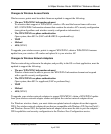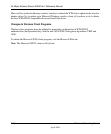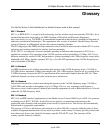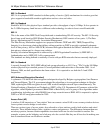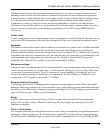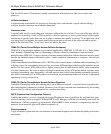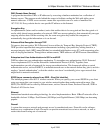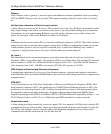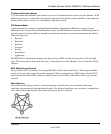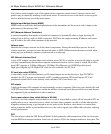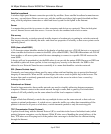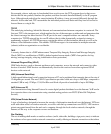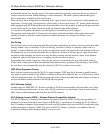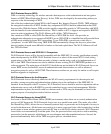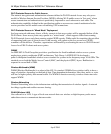
54 Mbps Wireless Router WGR614v7 Reference Manual
-12 Glossary
April 2006
can benefit from the free wireless access. The open connections typically come from the access points of
wireless networks located within buildings to serve enterprises. The chalk symbols indicate the type of
access point that is available at that specific spot.
There are three basic designs that are currently used: a pair of back-to-back semicircles, which denotes an
open node; a closed circle, which denotes a closed node; a closed circle with a “W” inside, which denotes a
node equipped with WEP. Warchalkers also draw identifiers above the symbols to indicate the password that
can be used to access the node, which can easily be obtained with sniffer software.
As a recent development, the debate over the legality of warchalking is still going on.
The practice stems from the U.S. Depression-era culture of wandering hobos who would make marks
outside of homes to indicate to other wanderers whether the home was receptive to drifters or was
inhospitable.
War Driving
War driving is the act of locating and possibly exploiting connections to wireless local area networks while
driving around a city or elsewhere. To do war driving, you need a vehicle, a computer (which can be a
laptop), a wireless Ethernet card set to work in promiscuous mode, and some kind of an antenna which can
be mounted on top of or positioned inside the car. Because a wireless LAN may have a range that extends
beyond an office building, an outside user may be able to intrude into the network, obtain a free Internet
connection, and possibly gain access to company records and other resources.
Some people have made a sport out of war driving, in part to demonstrate the ease with which wireless
LANs can be compromised. With an omnidirectional antenna and a geophysical positioning system (GPS),
the war driver can systematically map the locations of 802.11b wireless access points.
WEP (Wired Equivalent Privacy)
Basic wireless security provided by Wi-Fi. In some instances, WEP may be all a home or small-business
user needs to protect wireless data. WEP is available in 40-bit (also called 64-bit), or in 108-bit (also called
128-bit) encryption modes. As 108-bit encryption provides a longer algorithm that takes longer to decode, it
can provide better security than basic 40-bit (64-bit) encryption.
Wi-Fi (Wireless Fidelity)
Another name for IEEE 802.11b. Products certified as Wi-Fi are interoperable with each other even if they
are from different manufacturers. A user with a Wi-Fi product can use any brand of access point with any
other brand of client hardware that is built to the Wi-Fi standard.
Wi-Fi Alliance (formerly WECA – Wireless Ethernet Compatibility Alliance)
The Wi-Fi Alliance is a nonprofit international association formed in 1999 to certify interoperability of
wireless Local Area Network products based on IEEE 802.11 specification. Currently the Wi-Fi Alliance
has 193 member companies from around the world, and 509 products have received Wi-Fi certification since
certification began in March of 2000. The goal of the Wi-Fi Alliance's members is to enhance the user
experience through product interoperability (www.weca.net).



